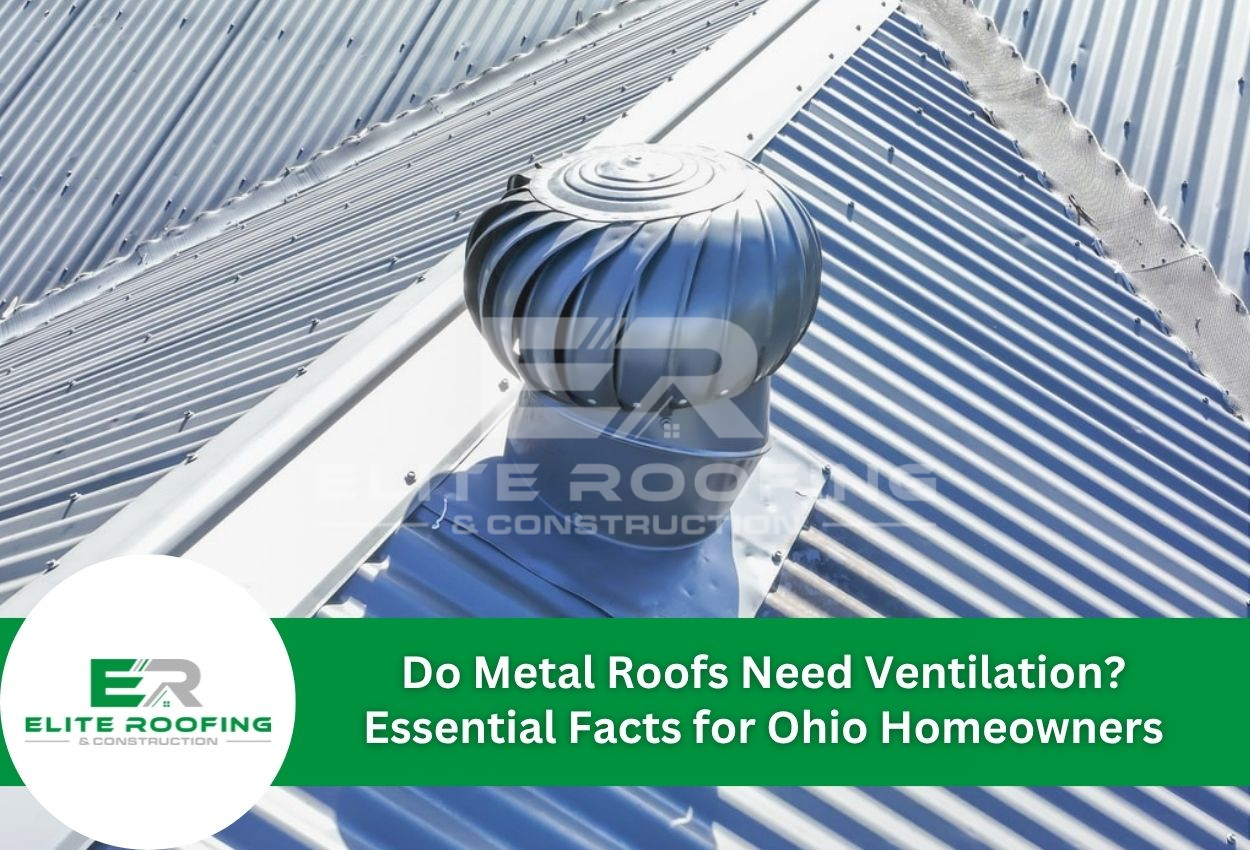Metal roofs are becoming more popular for Southern Ohio homes, but many property owners are surprised to learn that these roofing systems require ventilation. Despite the common misconception that metal roofs are completely maintenance-free, adequate airflow is critical to their performance and lifespan. Without proper ventilation, even the most premium metal roofing materials can suffer from preventable damage.
In Ohio’s humid summers and frigid winters, metal roof ventilation is even more important. The significant temperature fluctuations can lead to condensation buildup under an improperly ventilated metal roof, potentially causing insulation damage, mold growth, and even structural issues over time.
Metal roof attic ventilation helps regulate temperature extremes, prevents moisture accumulation, and protects your roofing investment. A well-designed ventilation system for metal roofs includes intake vents at the eaves and exhaust vents near the ridge, creating a continuous airflow that removes hot, moist air before it can cause problems.
Understanding the specific ventilation requirements for metal roofing systems is essential, whether you’re installing a new roof or maintaining an existing one. The right ventilation solution depends on your home’s design, local climate, and the specific type of metal roofing material used.
The Science Behind Metal Roof Ventilation
Understanding the physics behind metal roof ventilation reveals why it’s so crucial for roof longevity. Metal roofing materials conduct heat efficiently, which means they can quickly transfer exterior heat to the attic space below. Without proper ventilation, this heat becomes trapped, creating a sauna-like environment that can reach temperatures of 150 degrees Fahrenheit or higher during summer. This extreme heat accelerates the deterioration of roofing components and can warp wooden structural elements.
Moisture management is also important. As warm, humid air rises from living spaces, it can condense when it contacts cooler surfaces underneath your metal roof. This condensation leads to rust, corrosion, and deterioration of fasteners and roofing materials over time. Proper airflow prevents this moisture accumulation by allowing it to escape before damage occurs.
Southern Ohio experiences high humidity during summer months, often exceeding 80%, while winter brings significant temperature fluctuations. These conditions create the perfect environment for condensation problems in poorly ventilated spaces. Additionally, our seasonal rainfall patterns mean that moisture management is a year-round concern for metal roof systems.
Metal roof attic ventilation requirements aren’t optional but essential for maintaining structural integrity. A ventilated metal roof creates a balanced system that manages both heat and moisture effectively.
Signs Your Metal Roof Doesn’t Have Sufficient Ventilation
Identifying ventilation problems early can save Ohio homeowners significant repair costs down the road. One of the most noticeable indicators is excessive attic heat, specifically during summer. If your attic feels like an oven when you climb up there in July or August, your metal roof likely lacks adequate airflow. This trapped heat doesn’t just make your attic uncomfortable — it forces your cooling system to work harder, leading to noticeably higher energy bills.
Winter brings its own warning signs. Ice dams along roof edges indicate heat is escaping from your living space and warming the roof surface, causing snow to melt and refreeze at the eaves. These ice dams can be particularly damaging to metal roof fasteners and seams.
Inside your home, moisture-related problems signal ventilation issues. Mold or mildew growth on attic surfaces, damp insulation, or warped wood in roof structures are red flags that humidity isn’t escaping. In Southern Ohio’s humid climate, these problems accelerate quickly and can compromise your roof deck and supporting structures.
Premature aging of roofing components provides another clear indication. Rust on metal panels, deteriorating underlayment, or corrosion around fasteners suggest that moisture is being trapped beneath your metal roofing system. Even the most durable metal roofs can’t withstand constant exposure to trapped moisture.
Components of an Effective Metal Roof Ventilation System
Creating a ventilation system for your metal roof requires a balance of intake and exhaust components. When designed correctly, these elements work together to create continuous airflow that protects your Southern Ohio home from moisture damage and excessive heat buildup. Correct sizing is crucial — a general rule is 1 square foot of ventilation for every 300 square feet of attic space.
Intake ventilation options start at the lowest points of your roof. Soffit vents, installed under the eaves, provide an entry point for fresh air and should deliver 50% of your total ventilation. For homes without soffits, fascia vents installed along the roofline or drip edge vents that integrate with your metal roofing system are excellent alternatives.
Exhaust ventilation creates the “draw” that pulls air through your attic. Ridge vents, running along the peak of your roof, provide excellent exhaust ventilation for metal roofing systems. Box vents, installed near the ridge, work well for complex roof designs where continuous ridge vents aren’t possible. Power vents offer mechanical assistance for particularly challenging ventilation situations, though they require electricity and more maintenance.
The key to effective metal roof ventilation is creating a balanced system where intake and exhaust components work together. This balanced approach prevents condensation issues while extending the life of your metal roof. For many Ohio homes with metal roofs, a combination of soffit vents and ridge vents provides optimal performance year-round.
Benefits of Metal Roof Ventilation Beyond Moisture Control
While preventing moisture damage is a critical function of metal roof ventilation, the benefits go beyond simple condensation control. A properly ventilated metal roof delivers significant advantages that impact your entire home’s performance and comfort. For Southern Ohio homeowners, these additional benefits represent substantial value that makes ventilation a wise investment.
Energy efficiency stands out as a major advantage of well-ventilated metal roofing systems. During the hot summer months, ventilation prevents heat buildup in your attic space, reducing the cooling load on your air conditioning system and leading to energy savings. Additionally, by reducing temperature extremes, ventilation helps preserve the reflective qualities of metal roofs that make them energy efficient in the first place.
The lifespan of your roofing system also benefits tremendously. By maintaining moderate temperatures and preventing moisture accumulation, ventilation reduces stress on roofing components. This helps preserve the structural integrity of roof decking, prevents premature aging of underlayment materials, and maintains the protective finishes on metal panels. The result is a roofing system that can perform at peak efficiency for decades rather than years.
Indoor comfort improves as well. A properly ventilated metal roof helps maintain consistent temperatures throughout your home, eliminating hot spots and cold zones that make living spaces uncomfortable. In Ohio, this consistent temperature control creates a more pleasant indoor environment year-round while potentially improving indoor air quality by preventing conditions that promote mold growth.
Professional Installation vs. DIY: Making the Right Choice for Metal Roof Ventilation
When it comes to metal roof ventilation improvements, homeowners often wonder whether to tackle the project themselves or hire professionals. The answer depends on several factors, including your experience level, the complexity of the job, and safety considerations. For basic maintenance like clearing existing vents or installing simple soffit vent inserts, DIY approaches may be appropriate for those with some home improvement experience and safety equipment.
However, more complex ventilation solutions typically need professional expertise. Installing ridge vents on metal roofs requires specialized knowledge of metal roofing systems, sealing techniques, and specific tools. Mistakes during installation can compromise your roof’s weather resistance and potentially void warranties. Working on metal roofs can also be dangerous — these surfaces become extremely slippery when wet or dusty and conduct heat intensely during warm weather.
When selecting a roofing contractor in Southern Ohio for ventilation work, look for specialists with specific metal roofing credentials and experience. Ask potential contractors about their familiarity with the specific ventilation requirements for your roof type and how they address our region’s humidity challenges. Qualified professionals should willingly provide references from similar projects and carry insurance coverage.
Local contractors familiar with Southern Ohio’s climate will recommend appropriate ventilation solutions for our specific conditions. They understand how seasonal humidity shifts affect metal roofing systems and can implement ventilation strategies that perform effectively year-round. While professional installation is an investment, the long-term benefits of correctly installed ventilation far outweigh the initial costs.
Maintenance Tips for Your Metal Roof’s Ventilation System
A well-ventilated metal roof requires regular maintenance to continue performing at its best. Establishing a consistent maintenance routine helps ensure your metal roof’s ventilation pathways remain clear and functional throughout the year, protecting your investment and maintaining energy efficiency.
Fall maintenance is critical in Ohio because falling leaves, seeds, and debris can quickly clog intake vents and reduce airflow. Inspect soffit and ridge vents carefully, removing any accumulated debris that might obstruct air movement. Check that insulation hasn’t shifted to block soffit vents, as this common problem can significantly reduce ventilation efficiency. Before winter arrives, ensure all vent screens are intact to prevent pest intrusion while maintaining sufficient airflow.
Winter brings its own challenges, as snow can block ridge vents and reduce exhaust capacity. After heavy snowfall, visually inspect your roof to make sure your ridge vents remain clear. Never attempt to remove snow from metal roofs yourself — the slippery surface creates extreme safety hazards. If you notice ice dams despite having ventilation installed, this indicates your current system may be inadequate for your home’s needs.
As your metal roof ages, periodically evaluate whether your ventilation system still meets your needs. Modifications to your home, changes in insulation, or the addition of living space can alter ventilation requirements. Most metal roof ventilation systems should be professionally evaluated every five to seven years to ensure they are performing as intended and to address any developing issues before they cause damage.
Keep Your Metal Roof Properly Ventilated with Elite Roofing & Construction
Understanding the necessity of ventilation for your metal roof is crucial, especially in Southern Ohio. If you’ve noticed signs like increased attic heat during summer or ice dams in the winter, it might be time to reassess your ventilation system. Elite Roofing & Construction specializes in optimizing metal roof ventilation to enhance your home’s energy efficiency and protect its structural integrity.
Don’t let improper ventilation compromise the durability and performance of your metal roofing system. Excessive moisture and heat can lead to significant damage, affecting everything from your roof’s materials to the comfort of your living space. To keep your roof in peak condition, call Elite Roofing & Construction at (937) 500-7663. Our experts are ready to provide you with the best solutions for your home’s needs.

